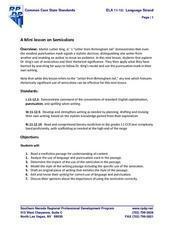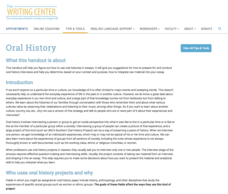Southern Nevada Regional Professional Development Program
A Mini lesson on Semicolons
Dr. Martin Luther King, Jr.'s "Letter from Birmingham Jail" serves as an exemplar for a mini-instructional activity on semicolons. Working alone or in small groups, class members first circle all the semicolons in the letter, and then...
PBS
Family History: Those with Lofty Ideals
Would you stand up for your beliefs, no matter the cost? Scholars investigate their own families to uncover examples of how and when someone stood up for their ideals. Using video clips, interviews, and eulogies, they come to understand...
The New York Times
Literary Pilgrimages: Exploring the Role of Place in Writers’ Lives and Work
Do the places you have lived influence what you write? Class members research the lives of writers and look for how places these writers have lived might have influenced their writings.
Deliberating in a Democracy
Parental Liability
How many teenagers have wanted their parents to let them make their own decisions? The answer is ... all of them! Scholars investigate where parental liability begins and ends in the eyes of the law. Using case studies and legal...
Museum of Disability
Taking Down Syndrome to School
Teach your class about the ways they can befriend and understand people who are different from them with a reading comprehension lesson. As youngsters read Taking Down Syndrome to School by Jenna Glatzer, they answer a series of...
Harper Collins
Amazing Women
Helen Keller became a teacher after her experience with Anne Sullivan, demonstrating to the world how valuable a dedicated mentor and determined spirit can be when overcoming adversity. Middle schoolers learn more about the influential...
University of North Carolina
Oral History
There's no better way to learn something than to hear it straight from the horse's mouth. A handout on oral history, part of a larger series on specific writing assignments, explains how to conduct interviews and use the information...
Perkins School for the Blind
Bagging Groceries
Bagging groceries is a skill that can help learners with visual impairments understand organizing, problem solving, and weight discrimination. In addition, it is also a wonderful job skill. Help learners as they determine how to bag...
American Evolution
Virginia Runaway Slave Ads
What does an ad reveal about a culture, or about the values of its intended audience? Class members examine a series of runaway slave ads—one of which was written by Thomas Jefferson—and consider what these primary source documents...
Curated OER
Crossword Puzzle - Question Words
There are six essential words to know when creating questions: who, what, when, where, why, and how. To get youngsters thinking about these words, have them complete this quick crossword puzzle. Clues are basic, and learners should be...
Achievement Strategies
Fishbone for Main Ideas and Details
A key reading comprehension skill is the ability to identify the main idea and supporting details used in a passage of informational text. Here's a template that encourages young readers to practice this skill. They list the who, what,...
Curated OER
Worksheet 1: Question Words
While this worksheet is short, it provides a quick review of forming sentences using who, what, where, when and why. This 6 question activity could be used in an elementary class or with ESL students.
Curated OER
Who, What, When, Where, Why, and the Media
Students in a preschool classroom discuss potentially fearful current events in a way they can understand. They write or draw about a current event, discussing the 5 W's of news reporting.
Curated OER
5 W's Circle Graphic Organizer
In this language arts worksheet, students complete a 5 W's circle graphic organizer. They fill our the who, what, where, why, and when ovals around the center oval which is labeled for the topic.
Curated OER
ESOL Recognize Basic Questions
Students review information questions with who, what, when and where. They orally practice answering questions as a class then work in pairs to practice all questions and answers orally.
Mary Pope Osborne, Classroom Adventures Program
Dinosaurs Before Dark
Young readers travel back to the time of the dinosaurs in this literature unit based on the story Dinosaurs Before Dark. Intended for use with upper-elementary special education students, this resource provides reading comprehension,...
Curated OER
The Whole Story
Students collect and convey information about a current event. By focusing on who, what, when, where, why, and how questions, students study to thoroughly analyze and report on important world events.
Curated OER
Sum It Up !!
Students practice various comprehension strategies to generate the main idea of the text. They encounter unfamiliar concepts and new vocabulary in their quest of the main idea in "Watson's Goes to Burmingham." The Five W's (What, Where,...
Curated OER
Newsworthy Fairy Tales
Third graders review common fairy tales and work in teams to rewrite the fairy tales as news articles. They answer questions using the 5 Ws (who, what, where, when, why). Student articles include eye-catching headlines.
Curated OER
Question Creation Chart Q-Chart
For this grammar and writing worksheet, students create questions using one word from the left hand column of the chart, and one word from the top row. They write the questions using who, what, where, when, how, and why. They add is,...
Curated OER
Question Word Wizard
This literacy PowerPoint instructs students on how to answer the five W's (who, what, when, where, why and how). Each slide contains hints on how to answer the question word appropriately and with detail.
Curated OER
The First Amendment, What it Means and When Libel Comes in to Play
Students research three topics: The First Amendment, John Peter Zenger and his trial, and libel. For this journalism and libel lesson, students discuss things authority figures have done they disagree with and the anit-sedition law....
Curated OER
When You're A Jet ...
A short article from the Learning Network covering the trading of quarterback Tim Tebow to the New York Jets. This is really just a time filler or something to do on a rainy day in your PE class.
Houghton Mifflin Harcourt
Practice Book: The Boy Who Saved Baseball
An array of reading comprehension, grammar, spelling, and vocabulary activities are at your fingertips with a language arts practice packet. Second, third, and fourth graders work on various skills using reading passages and word banks,...

























